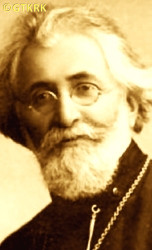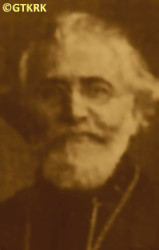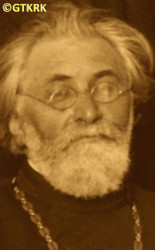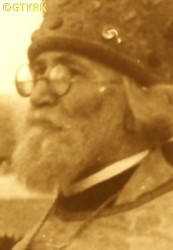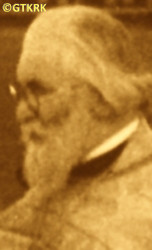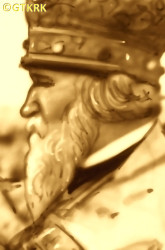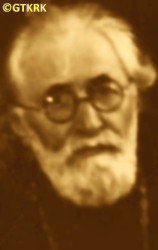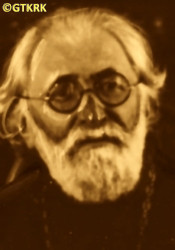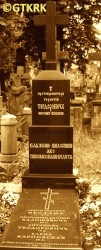Roman Catholic
St Sigismund parish
05-507 Słomczyn
85 Wiślana Str.
Konstancin deanery
Warsaw archdiocese, Poland
full list:
displayClick to display full list

searchClick to search full list by categories
wyświetlKliknij by wyświetlić pełną listę po polsku

szukajKliknij by przeszukać listę wg kategorii po polsku

Martyrology of the clergy — Poland
XX century (1914 – 1989)
personal data
surname
TEODOROWICZ
forename(s)
Terrence (pl. Terencjusz)
function
presbiter (i.e. iereus)
creed
Eastern Orthodox Church ORmore on
en.wikipedia.org
[access: 2014.09.21]
diocese / province
Warsaw‐Chełm OR eparchy (Polish Autocephalous Orthodox Church PAOC)
Warsaw‐Vistula OR eparchymore on
pl.wikipedia.org
[access: 2023.07.16]
academic distinctions
Sacred Orthodox Theology Candidate
date and place
of death
25.09.1939

Warsawtoday: Warsaw city pov., Masovia voiv., Poland
more on
en.wikipedia.org
[access: 2021.10.09]
details of death
During World War I after Russian defeat by German and Austro–Hungarian troops at battle of Gorlice in 05.1915 left Warsaw — together virtually all Orthodox clergy and millions of Russian officials, teachers, military personnel, etc., i.e. members of the Russian administration in Russian–occupied Poland — and went east (during a mass exodus known as bezhenstvo).
Resided in Sankt Petersburg and Moscow.
Returned on 14.08.1921, after Poland regained independence and was victorious in Polish–Russian war of 1919‐1921.
After German invasion of Poland in 09.1939 (Russians invaded Poland 17 days later) and start of the World War II perished during Warsaw siege and aerial bombardment by the Germans called „Black Monday”.
cause of death
mass murder
perpetrators
Germans
sites and events
Warsaw (Black Monday)Click to display the description, Air raids 1939Click to display the description, Ribbentrop‐MolotovClick to display the description, Polish‐Russian war of 1919‐1921Click to display the description
date and place
of birth
10.04.1867

Verbychnetoday: Turiisk hrom., Kovel rai., Volyn obl., Ukraine
more on
uk.wikipedia.org
[access: 2023.03.02]
presbyter (holy orders)
ordination
17.09.1895

Pochaivtoday: Pochaiv urban hrom., Kremenets rai., Ternopil obl., Ukraine
more on
en.wikipedia.org
[access: 2020.09.27]
Dormition of the Mother of God OR churchmore on
en.wikipedia.org
[access: 2023.02.20] (Pochaiv Lavra)
positions held
31.05.1939
retired (i.e. „at rest”)
01.09.1921 – 1939
parish priest — Warsawtoday: Warsaw city pov., Masovia voiv., Poland
more on
en.wikipedia.org
[access: 2021.10.09] ⋄ Holy Trinity OR cathedral church — also: from 1923 secretary of the Educational Committee at the Holy Synod, from 1924 organizer and from 1925 deputy chairman of the Orthodox Metropolitan Charitable Society, in 1930 and 1935 member of the Pre–Council Assembly of the Polish Orthodox Church, collaborator of the „Help for Political Prisoners” committee supporting the repressed Orthodox clergy in Soviet Russia
08.09.1924
protopresbiter — Polish Autocephalous Orthodox Church PACP ⋄ Warsaw‐Chełm OR eparchy — dignity conferment
1922
mitred — Russian Orthodox Church — dignity conferment, the right to wear the liturgical headgear in the form of a four–part closed crown with images of God, the Mother of God and some saints, decorated with precious stones
1921 – 1924
membership — Warsawtoday: Warsaw city pov., Masovia voiv., Poland
more on
en.wikipedia.org
[access: 2021.10.09] ⋄ Spiritual Orthodox Consistory ⋄ Warsaw‐Chełm OR eparchy
1918 – 1921
parish priest — Sankt Petersburgtoday: Saint Petersburg city, Russia
more on
en.wikipedia.org
[access: 2020.07.31] ⋄ Transfiguration of the Lord OR church (on Aptekarsky Island)
28.08.1917 – 20.09.1918
membership — Moscowtoday: Moscow city, Russia
more on
en.wikipedia.org
[access: 2020.07.31] ⋄ Local Council of the Russian Orthodox Church, Russian Orthodox Church ⋄ Assumption of the Blessed Virgin Mary OR cathedral church — as the representative of the emergency Warsaw–Vistula eparchy congress of clergy and laity that was held in 1917 in Moscow (most of the Orthodox clergy fled from Polish territory in 1915 — so‐called bezhenstvo) under his chairmanship
16.07.1909 – 1915
membership — Warsawtoday: Warsaw city pov., Masovia voiv., Poland
more on
en.wikipedia.org
[access: 2021.10.09] ⋄ Spiritual Orthodox Consistory ⋄ Warsaw‐Vilnius OR eparchy
1910 – 1915
parish priest — Warsawtoday: Warsaw city pov., Masovia voiv., Poland
more on
en.wikipedia.org
[access: 2021.10.09] ⋄ Dormition of the Blessed Virgin Mary OR church — also: teacher in the 3rd Russian State Gymnasium for Girls at 36 Krakowskie Przedmieście, law teacher at school of commerce and gymnasium for boys
01.07.1903 – 1910
steward — Warsawtoday: Warsaw city pov., Masovia voiv., Poland
more on
en.wikipedia.org
[access: 2021.10.09] ⋄ Holy Trinity OR cathedral church — also: teacher in the 3rd Russian State Gymnasium for Girls at 36 Krakowskie Przedmieście (from c. 1907), head of a one–class church school for girls by the cathedral (c. 1906)
from 01.10.1902
priest — Warsawtoday: Warsaw city pov., Masovia voiv., Poland
more on
en.wikipedia.org
[access: 2021.10.09] ⋄ Holy Trinity OR cathedral church — 4th vicar
1895 – 1902
parish priest — Dratówtoday: Ludwin gm., Łęczna pov., Lublin voiv., Poland
more on
en.wikipedia.org
[access: 2021.08.20] ⋄ St Nicholas the Wonderworker OR parish
17.09.1895
presbiter (Eng. priest, i.e. iereus) — Russian Orthodox Church — priesthood cheirotonia, i.e. ordination, on 14.09.1895 preceded by deacon cheirotonia
1892 – 1895
teacher — Kremenetstoday: Kremenets urban hrom., Kremenets rai., Ternopil obl., Ukraine
more on
en.wikipedia.org
[access: 2020.10.18] ⋄ Russian language, Eparchy's Orthodox School for women — in the buildings of the famous Krzemieniec Lyceum closed in 1931 by the occupying Russian authorities (earlier, the Jesuit college also closed by the Russians)
till 1892
student — Moscowtoday: Moscow city, Russia
more on
en.wikipedia.org
[access: 2020.07.31] ⋄ Orthodox philosophy and theology, Orthodox Theological Academy — postgraduate specialised studies crowned with Sacred Theology Candidate's degree
1881 – 1887
student — Kremenetstoday: Kremenets urban hrom., Kremenets rai., Ternopil obl., Ukraine
more on
en.wikipedia.org
[access: 2020.10.18] ⋄ philosophy and theology, Orthodox Theological Seminary
married — four children
others related
in death
BIAŁAClick to display biography Anne Praxedes (Sr Adolphine), CHOINAClick to display biography Sophia, CZAJKOWSKAClick to display biography Marianne Casimira, CZYMEKClick to display biography Charles, DREWNIKOWSKAClick to display biography Stephanie, GĄSIOROWSKIClick to display biography Francis, GRZEGORCZYKClick to display biography Francis (Bro. Thaddeus), HATKOClick to display biography Francis (Fr Matthew), KACZMAREKClick to display biography Josefa (Sr Andrea), KISIELEWSKAClick to display biography Christine Irene, KRAWCZYKClick to display biography Theodosia, LANGERClick to display biography John, LEOŃCZUKClick to display biography Marianne, LEWANDOWSKAClick to display biography Eleonor, LEWANIUKClick to display biography Aleksandra, ŁĄCZEKClick to display biography Marianne, MIKOŁAJEWSKAClick to display biography Helen, NIEDŹWIECKAClick to display biography Marianne, NIKUTAClick to display biography Cecilia Aleksandra, OPIELAClick to display biography Joseph, OSTROWSKIClick to display biography Stanislav Kostka Chris Alexander (Fr Josaphat), PSZENNAClick to display biography Wanda, RANIECKAClick to display biography Mary Agatha, RUSZKOWSKAClick to display biography Stanislava, SASAKClick to display biography Josefa Aleksandra, SELMAClick to display biography Alice Janet, SIEMIŃSKAClick to display biography Petronella, WÓJCIKClick to display biography Marianne, ZEMBRZUSKAClick to display biography Casimira
sites and events
descriptions
Warsaw (Black Monday): German Germ. Luftwaffe (Eng. Air Force) the first air raids on Warsaw — attacking, among others, Warsaw housing estates — carried out on the first day of the war, 01.09.1939. The first major German assault on the capital on 08.09.1939 was repelled. On 17.09.1939, over 5,000 artillery shells and aircraft bombs fell on the city. On 22.09.1939, the German encirclement ring closed around Warsaw. On 25.09.1939 from 7:00 till late evening more than 400 German bombers made aerial raids on Warsaw. Almost 630 tons of explosives, both incendiary and demolishing were dropped. Caused c. 200 fires. Public building were not spared, including hospitals clearly marked with Red Cross signs (in fact they were targeted in the first place). Holy Ghost hospital was among them and c. 700 people, both patients and staff were killed (including 20 Vincentian sisters). Altogether during those saturation raids called „Black Monday” c. 10,000 people perished, 35,000 were wounded, mostly civilian. The raids were in contravention of Hague agreements and must be regarded as an act of war crime. (more on: pl.wikipedia.orgClick to attempt to display webpage
[access: 2015.04.18])
Air raids 1939: During invasion of Poland commenced on 01.09.1939 Germans systematically attacked civilian targets. Many cities (Wieluń, Frampol, Warszawa, Lwów, Łomża, Puck, etc.) were bombed during air raids and totally destroyed. The hospitals and churches, visibly marked as such, were not spared. German planes also attacked columns of fleeing people on the roads, massacring them. It is estimated that c. 150,000‐200,000 civilians were killed or murdered by the Germans in 09.1939. (more on: en.wikipedia.orgClick to attempt to display webpage
[access: 2015.04.18])
Ribbentrop‐Molotov: Genocidal Russian‐German alliance pact between Russian leader Joseph Stalin and German leader Adolf Hitler signed on 23.08.1939 in Moscow by respective foreign ministers, Mr. Vyacheslav Molotov for Russia and Joachim von Ribbentrop for Germany. The pact sanctioned and was the direct cause of joint Russian and German invasion of Poland and the outbreak of the World War II in 09.1939. In a political sense, the pact was an attempt to restore the status quo ante before 1914, with one exception, namely the „commercial” exchange of the so‐called „Kingdom of Poland”, which in 1914 was part of the Russian Empire, fore Eastern Galicia (today's western Ukraine), in 1914 belonging to the Austro‐Hungarian Empire. Galicia, including Lviv, was to be taken over by the Russians, the „Kingdom of Poland” — under the name of the General Governorate — Germany. The resultant „war was one of the greatest calamities and dramas of humanity in history, for two atheistic and anti‐Christian ideologies — national and international socialism — rejected God and His fifth Decalogue commandment: Thou shall not kill!” (Abp Stanislav Gądecki, 01.09.2019). The decisions taken — backed up by the betrayal of the formal allies of Poland, France and Germany, which on 12.09.1939, at a joint conference in Abbeville, decided not to provide aid to attacked Poland and not to take military action against Germany (a clear breach of treaty obligations with Poland) — were on 28.09.1939 slightly altered and made more precise when a treaty on „German‐Russian boundaries and friendship” was agreed by the same murderous signatories. One of its findings was establishment of spheres of influence in Central and Eastern Europe and in consequence IV partition of Poland. In one of its secret annexes agreed, that: „the Signatories will not tolerate on its respective territories any Polish propaganda that affects the territory of the other Side. On their respective territories they will suppress all such propaganda and inform each other of the measures taken to accomplish it”. The agreements resulted in a series of meeting between two genocidal organization representing both sides — German Gestapo and Russian NKVD when coordination of efforts to exterminate Polish intelligentsia and Polish leading classes (in Germany called «Intelligenzaktion», in Russia took the form of Katyń massacres) where discussed. Resulted in deaths of hundreds of thousands of Polish intelligentsia, including thousands of priests presented here, and tens of millions of ordinary people,. The results of this Russian‐German pact lasted till 1989 and are still in evidence even today. (more on: en.wikipedia.orgClick to attempt to display webpage
[access: 2015.09.30])
Polish‐Russian war of 1919‐1921: War for independence of Poland and its borders. Poland regained independence in 1918 but had to fight for its borders with former imperial powers, in particular Russia. Russia planned to incite Bolshevik‐like revolutions in the Western Europe and thus invaded Poland. Russian invaders were defeated in 08.1920 in a battle called Warsaw battle („Vistula river miracle”, one of the 10 most important battles in history, according to some historians). Thanks to this victory Poland recaptured part of the lands lost during partitions of Poland in XVIII century, and Europe was saved from the genocidal Communism. (more on: en.wikipedia.orgClick to attempt to display webpage
[access: 2014.12.20])
sources
personal:
pl.wikipedia.orgClick to attempt to display webpage
[access: 2013.05.19], uk.wikipedia.orgClick to attempt to display webpage
[access: 2020.09.27]
bibliographical:
„Hierachy, clergy and employees of the Orthodox Church in the 19th‐21st centuries within the borders of the Second Polish Republic and post–war Poland”, Fr Gregory Sosna, M. Antonine Troc-Sosna, Warsaw–Bielsk Podlaski 2017
original images:
drevo-info.ruClick to attempt to display webpage
[access: 2020.09.27], audiovis.nac.gov.plClick to attempt to display webpage
[access: 2020.09.27], audiovis.nac.gov.plClick to attempt to display webpage
[access: 2020.09.27], audiovis.nac.gov.plClick to attempt to display webpage
[access: 2020.09.27], audiovis.nac.gov.plClick to attempt to display webpage
[access: 2020.09.27], audiovis.nac.gov.plClick to attempt to display webpage
[access: 2020.09.27], audiovis.nac.gov.plClick to attempt to display webpage
[access: 2020.09.27], www.polskipetersburg.plClick to attempt to display webpage
[access: 2020.09.27], pl.wikipedia.orgClick to attempt to display webpage
[access: 2013.05.19]
LETTER to CUSTODIAN/ADMINISTRATOR
If you have an Email client on your communicator/computer — such as Mozilla Thunderbird, Windows Mail or Microsoft Outlook, described at WikipediaPatrz:
en.wikipedia.org, among others — try the link below, please:
LETTER to CUSTODIAN/ADMINISTRATORClick and try to call your own Email client
If however you do not run such a client or the above link is not active please send an email to the Custodian/Administrator using your account — in your customary email/correspondence engine — at the following address:

giving the following as the subject:
MARTYROLOGY: TEODOROWICZ Terrence
To return to the biography press below:
 Click to return to biography
Click to return to biography








